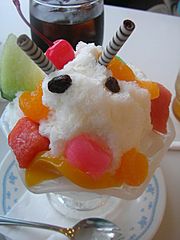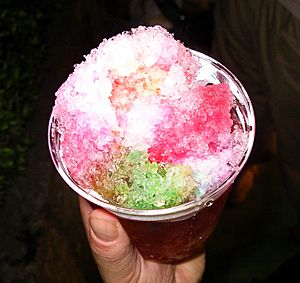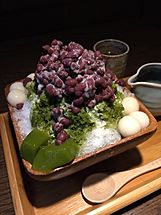Kakigōri facts for kids

Kakigōri with green tea flavor
|
|
| Type | Shaved ice |
|---|---|
| Course | Dessert |
| Place of origin | Japan |
| Main ingredients | Ice, syrup, condensed milk or evaporated milk |
| Variations | Shirokuma |
Kakigōri (かき氷) is a yummy Japanese shaved ice dessert. It's flavored with sweet syrup and often topped with condensed milk. It's a super popular treat, especially during Japan's hot summer months!
Contents
The History of Kakigōri
The story of kakigōri goes way back to the Heian period (around 794 to 1185 AD) in Japan. Back then, blocks of ice were saved during the cold winter. When summer arrived, this ice was shaved and served with sweet syrup. Only rich Japanese nobles could enjoy this cool treat!
A famous writer named Sei Shōnagon even mentioned kakigōri in her book, The Pillow Book. She worked for the Imperial Court during the Heian period.
Kakigōri became much more common in the 1800s. This was when ice became easier for everyone to get in the summertime. The first kakigōri shop is thought to have opened in Yokohama in 1869.
Did you know that July 25th is known as Kakigōri Day in Japan? This is because the Japanese pronunciation for the date sounds a bit like "summer ice." Also, on that day in 1933, Japan had a record-high temperature!
What is Kakigōri Like?
Traditionally, kakigōri is made using a hand-cranked machine. This machine spins a big block of ice over a sharp blade, creating fluffy shaved ice. Even though electric shavers are used a lot now, you can still see street vendors hand-shaving ice in the summer.
Instead of flavored ice, Kakigōri is usually made from pure ice. Often, this ice comes from frozen blocks of mineral water. Sometimes, the ice is even taken from natural springs! Before refrigerators, this special ice was kept in mountain caves or ice houses.
Kakigōri is similar to a snow cone, but it's different in important ways. It has a much smoother, fluffier ice texture, almost like fresh fallen snow. You almost always use a spoon to eat it. This unique texture is what makes kakigōri special. Because of how soft it is, some people even call it 'Angel Snow'!
There are many popular kakigōri flavors! These include strawberry, cherry, lemon, green tea, grape, melon, and "Blue Hawaii". Some shops even mix two or more syrups for colorful treats. To make it extra sweet, condensed milk or evaporated milk is often poured on top.
You can find kakigōri almost everywhere in Japan during the hot summer. It's sold at street stalls, festivals, convenience stores, coffee shops, and special kakigōri parlors. Many families also make it at home! At summer festivals like matsuri and bon odori, it's often served with other yummy street foods like yakisoba and takoyaki. Some shops even add ice cream or sweetened red beans to their kakigōri.
A common way to know if a place sells kakigōri is to look for a flag. This flag has the Japanese symbol for ice, which is kōri (氷).
Shirokuma: The White Bear Treat
 |
|
| Type | Kakigōri |
|---|---|
| Course | Dessert |
| Place of origin | Japan |
| Region or state | Kagoshima prefecture |
| Main ingredients | Ice, condensed milk |
Shirokuma (白熊 or しろくま) is a special type of kakigōri. It's made with shaved ice flavored with condensed milk. Then, it's topped with small, colorful mochi (chewy rice cakes), different fruits, and sweet bean paste. Common fruits include mandarin oranges, cherries, pineapples, and raisins.
Where is Shirokuma Popular?
Shirokuma has been a favorite in Kagoshima since the middle of the Edo period (1603-1868). Many Japanese people know about this delicious treat. You can enjoy it in cafés and some department stores, like Yamakataya or Mujaki.
Why is it Called Shirokuma?
The word Shirokuma literally means "white bear" in Japanese, like a polar bear. There are a few stories about how it got its name:
- One story says that a cotton shop in Kagoshima started selling kakigōri with condensed milk. The owner saw a picture of a polar bear on the condensed milk can and decided to name the dessert "Shirokuma."
- Another story comes from Mujaki, a coffee shop in Kagoshima City. They started making kakigōri with milk syrup, colorful jelly, sweet bean paste, and fruits. When arranged, these toppings looked like a polar bear's face from above! So, they called it Shirokuma.
You can find Shirokuma in supermarkets in southern Kyūshū, especially in Kagoshima City. Small candy stores also sell it. Shirokuma in cups are even sold in convenience stores all over Japan!
Ujikintoki: Green Tea Delight
Ujikintoki (宇治金時 or うじきんとき) is another type of Kakigōri. It's made with shaved ice, green tea syrup, sweet bean paste (made from Azuki beans), mochi, and green tea ice cream.
The Meaning Behind the Name
Ujikintoki gets its name from two things. "Uji" comes from the small city of Uji in Kyoto Prefecture. This city is very famous for its delicious green tea. "Kintoki" comes from Sakata Kintoki, a hero known as Kintarō in Japanese stories. The red bean paste in the dessert is named after Kintarō, whose face is often shown as red.
Other Fun Varieties
Yakigori: The Flaming Ice
Yakigori (焼き氷) is a unique type of Kakigōri. A special flavored liquid, often a type of brandy, is poured on top and then carefully lit on fire! This creates a cool flaming effect. Yakigori sometimes also has caramel sauce, ice cream, strawberries, or pineapple on top.
See also
 In Spanish: Kakigōri para niños
In Spanish: Kakigōri para niños




